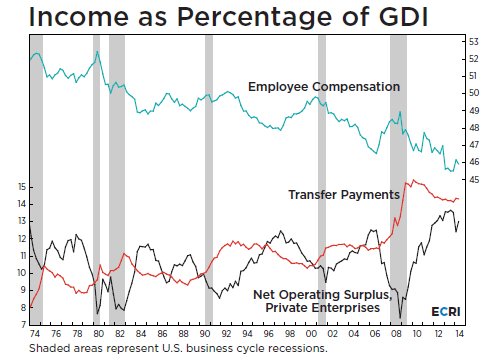My side? I've always made clear my criticisms of the GOP and will continue to do so. I always find it hilarious how you all are so intent on categorizing people. I'm not a GOP member. I'm officially listed as "Unaffiliated", since I vote both sides of the aisle. I am a social liberal and an economic conservative. So what does that make me? Half Dem, half GOP. Truth is, even the GOP is not as economically conservative as I am. It's really more accurate to call me Half Dem (social, environment) and Half Libertarian (economics and monetary).
Doesn't satisfy you, though, because you'd love to put me in a box with the GOP to discredit me. Unfortunately, that's not accurate. Sorry to disappoint you. You're going to have to work harder than that.
-----------
The Agony and the Ecstasy
Fed Chairman Janet Yellen is concerned about “nonexistent” real wage growth following the decline in real median family incomes by one-eighth between 2004 and 2013. How does this fit with the pickup in GDP and job growth?
The Bank of England’s Chief Economist, Andrew Haldane, recently unveiled two indexes, akin to the misery indexes of yore, that shed some light on this question. The “ecstasy index,” based on unemployment, inflation and GDP growth, shows the U.K. economy to be “firmly on the front foot,” if not quite ecstatic as yet. For the U.S., such an ecstasy index – perhaps adding equity prices to the mix – might arrive at a similar conclusion.
But Haldane’s “agony index,” containing real wages, real interest rates and productivity growth, is “at painfully low levels” in the U.K., as it is also likely to be in the U.S. It supports the hypothesis of secular stagnation, whose possible causes “include rising levels of inequality, worsening levels of educational attainment, a rising debt overhang, lower prices for investment goods, rising levels of youth unemployment and lower levels of innovation.” Surveying the evidence, Haldane leans towards the gloomier view.

ECRI’s analysis of different kinds of income over the past four decades (chart) reveals that employee compensation less Social Security contributions (teal line) as a percentage of Gross Domestic Income (GDI) has been trending down since the 1970s. It is now near a record low, consistent with the decline in real median family income since 2004 – especially with GDI itself growing at only a 1½% annual rate over that time period. This inexorable decline lies at the heart of the agonizing structural malaise gutting middle class incomes.
What have risen are transfer payments, which remain near a record high (red line), and the net operating surplus of private enterprises excluding fixed capital consumption (black line), which is near an ecstatic multi-decade high (black line).
We have, then, a longstanding structural headwind in the employee compensation share of GDI, whose own growth rate has been struggling to stay above the Fed’s 2% “stall speed” since the Great Recession. Having dipped below 2% away from recession only once in the previous half-century, this GDI measure has done so four times in the last four years or so, recalling the fact that Japan – where trend growth is even lower – is now on the cusp of its fourth outright recession since 2008, validating our ” yo-yo years” thesis. Indeed, since Q3 2012, GDI growth has actually averaged under 2% a year in the U.S. – less than the “stall speed” itself.
Ms. Yellen has said that the purpose of the Fed’s accommodative policy, including QE, is to get the economy back to “business as usual.” This requires the Fed to achieve “liftoff” for the Fed Funds Rate to rise above the zero lower bound before the next recession hits, allowing the Fed to then cut rates as it used to. This is the elephant in the room: what if they are unable to do so? Maybe, in the yo-yo years, one can never get back to “business as usual.”
In The Agony and the Ecstasy, news arrives one night that, “instead of getting better, Lorenzo [de’ Medici] was failing. A new doctor had been sent for, Lazzaro of Pavia, who had administered to Lorenzo a pulverized mixture of diamonds and pearls. This hitherto infallible medicine had failed to help.” Today, with the markets having started to suspect that “hitherto infallible” monetary medicine may no longer work, increasingly exotic prescriptions may have to be administered.
businesscycle.com |





